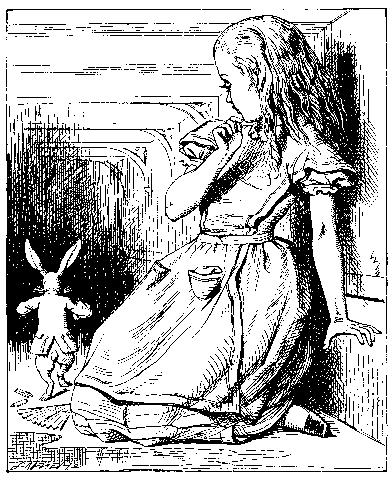We hunch ourselves over overpriced typewriters,
Hovering between letters like a
Fractious murmuration of starlings.
Our minds and bodies disconnected –
Two separate instruments
That move interdependently;
Mutually exclusive entities of
Limitless potential that are
Stunted
As they try to bud.
We are told that we need
MORE IDEAS;
The unseen, unheard, voices
Filter into our inboxes
Like a plague of synthetic locusts.
CREATIVITY
They scream,
ECONOMIC FORTITUDE
(We silently mouth the blanks)
Relies on the creative output
Of all members of the workforce.
Alice steps away from her monitor,
Her attention caught by a small
White rabbit with an oversized pocket watch.
GET BACK TO YOUR SEAT, ALICE
Comes the command.
THERE WILL BE NO RABBIT HOLES
(Alice silently mouths the blanks)
For me today.
Suddenly a thought blinks
Nakedly
Into the cloying light;
Its spindly limbs stretch out for
Nutrients and nourishment.
Alice thinks about sharing it,
But then remembers
The last time she tried to
DO SOMETHING FOOLISH.
Instead she closes her hands over
The delicate sapling
And silently counts to ten
As the buzzing of a million
Million empty voices
Flood into her inbox.

This science poem is inspired by the recent Merck State of Curiosity Report 2018. This report showcases results from a survey conducted with over 3,000 workers from China, Germany, and the United States. It seeks to give a deeper understanding of whether promoting curiosity to drive innovation is a sound investment – and which influencing factors are crucial for it.
Whilst 84% of respondents identified curiosity enhancers within their organisations, 64% highlighted barriers to curiosity. Interestingly, 90% of the respondents who described themselves as highly curious at work also noted that they received the time and training opportunities to develop new ideas in the workplace, which would suggest that people who identify as being curious likely do so because their workplace actively encourages and enables such behaviour. Similarly, the main obstacles to engendering curiosity in the workplace would appear to be oppressive, non-collaborative atmospheres, with the three main barriers found to be: top-down work environments, a lack of opportunity to exchange ideas, and over-supervising. The results of the report indicate that if workplaces wanted to encourage curiosity, and the advantages that this enables (such as the development of new innovations that drive economic benefit) then they should not only create opportunities for all of their workforce to be curious, but also trust them to do so in a relatively autonomous fashion. So, what’s your state of Curiosity?
Disclaimer: This post has been produced in cooperation with Merck. Merck is known as Merck KGaA, Darmstadt, Germany in the United States & Canada.
An audio version of this poem can be heard here:
Discover more from The Poetry of Science
Subscribe to get the latest posts sent to your email.